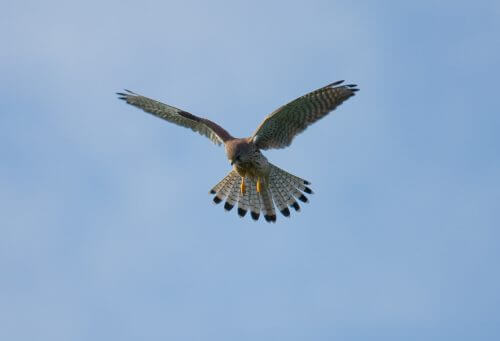Scientists from the RMIT University in Melbourne, Australia, developed the MAV, a miniature aircraft (Micro Air Vehicle) inspired by the way a Kestrel falcon hovers over its prey.

By: Dafna Haim Langford
Scientists from the RMIT University in Melbourne, Australia, developed the MAV, a miniature aircraft (Micro Air Vehicle) inspired by the way a Kestrel falcon hovers over its prey.
The Kestrel is characterized by hovering at a height of 20-10 meters above the prey without moving its wings, and at the appropriate moment it dives down towards the prey (small mammals, lizards or large insects). At RMIT University, they drew inspiration from the way the falcon hovers over its prey and developed a tiny fixed-wing aircraft that is able to reach heights while utilizing upward air movements.
The fact that birds use air currents to soar upwards while saving energy has been known for a long time. Air currents are created when wind meets a natural or artificial obstacle such as a cliff, or due to temperature differences between the air and the ground. However, hovering without wing propulsion allows the falcon to keep its head steady and locate the prey on the ground with maximum accuracy. The constant and precise hovering of the falcon led the researchers to try and develop a miniaturized aircraft based on the falcon-inspired wind-assisted hovering technique.
The researchers used polystyrene (foamed styrofoam) in the shape of a sail as part of the experimental platform. The lightweight material allowed the researchers to test the MAV in the field while taking advantage of several advantages, including the ability to fly in relatively weak winds while maintaining significant control in fast movement. After developing a control panel measuring 2.6x3.6 cm and connecting it to GPS, the MAV was tested near a hill and next to a building. On the side of the hill, the MAV reached a height of 120 meters and flew autonomously until the batteries ran out, while next to the building the MAV lasted only 20 seconds. At this stage, the MAV operates in a limited range of wind speeds without external energy, birds overcome this problem by changing the structure of the wing and moving the feathers.
The team of researchers has been working these days on imitating the way the wing and feathers of birds change in order to improve the MAV's takeoff efficiency.
Miniaturized aircraft that utilize the energy of wind currents could be used in the future to transfer packages, for surveillance missions and, of course, for search and rescue missions in disaster areas. The use of air currents optimizes energy utilization and will therefore extend the range of operation of any small aircraft.

2 תגובות
I saw a video about this thing on YouTube, looks like a simple plastic toy for ten year olds. It was interesting to see a performance comparison table (altitude, range, dwell time) between it and other small personal drones that exist in the IDF and other armies, to understand what the added advantage is here.
mistake again
It says "Kestrel falcon" and not her,
Because in the falcon family there is a subfamily in which types are sorted into species,
Kestrel is the popular name of a number of species,
In this case, the reference is to:
(common kestrel (Falco tinnunculus
whose Hebrew name is - common falcon.